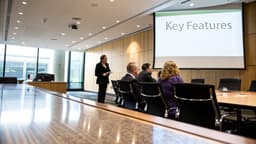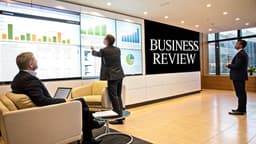Meetings are a cornerstone of modern work, yet many feel like a colossal waste of time. Endless discussions, unclear outcomes, and a lack of focus can drain team productivity and morale, leaving everyone wondering what was accomplished. The truth is, poorly run meetings aren't just an annoyance; they're a significant drain on company resources and a direct obstacle to progress. But it doesn’t have to be this way.
What if every meeting could be a catalyst for clear decisions and tangible action? The key lies not in having fewer meetings, but in having better ones. Adopting proven strategies can transform these gatherings from frustrating time-sinks into powerful, focused, and productive sessions. This guide breaks down the most essential meeting management best practices into a clear, actionable framework designed for immediate implementation.
We will cover eight core principles that will revolutionize how you plan, execute, and follow up on your meetings. From meticulous preparation and strategic use of technology to effective follow-up systems, these tactics will equip you to lead sessions that are not just efficient, but genuinely effective. You’ll learn precisely how to ensure every minute spent in a meeting is a minute invested in driving your goals forward.
1. Start with a Clear Agenda and Purpose
One of the most foundational meeting management best practices is to never hold a meeting without a clear, documented purpose and a structured agenda. An agenda is more than just a list of topics; it is a strategic roadmap that defines the meeting's "why" and "how." It communicates the goals, allocates time for each discussion point, and sets clear expectations for every participant, transforming a potential time-waster into a focused, productive session.
This approach ensures everyone arrives prepared and aligned on the objectives. It eliminates ambiguity and prevents conversations from drifting into unrelated territories. By defining the desired outcomes upfront, the agenda provides a benchmark for success, making it easy to determine if the meeting achieved its goals.
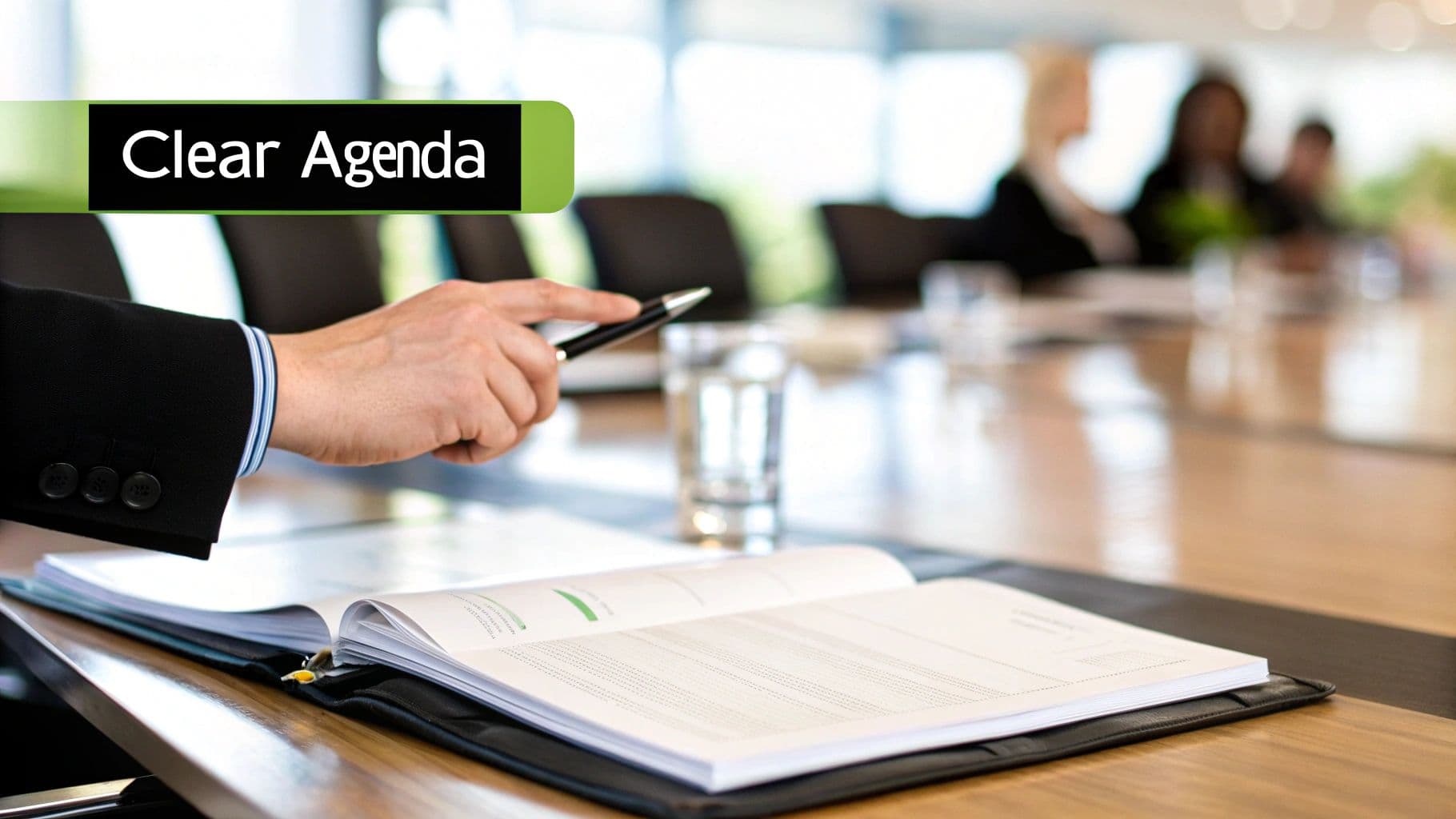
How to Implement a Purpose-Driven Agenda
Creating an effective agenda involves more than just jotting down a few bullet points. Follow these steps to build a document that drives results.
- Define the Core Objective: Start by answering a simple question: "What is the primary goal of this meeting?" Whether it's to make a decision, brainstorm ideas, or provide a status update, this objective should be stated clearly at the top of the agenda.
- Use Action-Oriented Language: Phrase agenda items as questions to be answered or decisions to be made. Instead of "Q3 Marketing Budget," use "Decide on final Q3 marketing budget allocation." This frames the discussion around a tangible outcome.
- Allocate Time and Assign Owners: Assign a specific time limit to each agenda item and designate a person to lead that part of the conversation. This fosters accountability and helps keep the meeting on schedule.
- Include a "Parking Lot": Add a section for off-topic but important ideas that arise. This acknowledges valuable contributions without derailing the meeting's primary focus. These items can be addressed later.
For example, Amazon famously uses a "narrative" memo format. Before discussion begins, attendees spend time silently reading a detailed, six-page document outlining the topic. This ensures everyone is fully informed and ready for a high-quality conversation, a practice that highlights the power of structured preparation.
2. Follow the Right People, Right Size Principle
A core tenet of effective meeting management best practices is to ensure that only the necessary participants are in the room. This principle focuses on inviting individuals who can actively contribute, make decisions, or are directly impacted by the outcomes. By prioritizing quality over quantity, you create a more engaged and efficient environment where every attendee has a clear purpose.
This selective approach prevents the common issue of passive observation, where oversized meetings dilute focus and slow down decision-making. A smaller, more relevant group ensures conversations are concise, relevant, and drive toward the meeting’s primary objectives, respecting everyone's time and maximizing productivity.

How to Implement the Right People, Right Size Principle
Adopting this principle requires a deliberate and strategic approach to building your invite list. Use these steps to curate the ideal group for any meeting.
- Apply the "Two-Pizza Rule": Popularized by Amazon's Jeff Bezos, this guideline suggests that a meeting is too large if it can't be fed with two pizzas. This simple heuristic helps keep teams small, agile, and focused on tangible results.
- Use a RACI Matrix: Before sending invites, map out who is Responsible, Accountable, Consulted, and Informed. Only those in the R, A, and C categories typically need to attend live. The "Informed" group can receive a summary or recording.
- Define Roles Clearly: Every invitation should come with an implicit or explicit understanding of the attendee's role. Are they a decision-maker, a subject matter expert, or a stakeholder providing key input? This clarity empowers participants to contribute effectively.
- Audit Recurring Meetings: Regularly review the attendee lists for standing meetings. As projects evolve, roles change, and not everyone who was initially required may still be necessary.
For instance, Steve Jobs was famous for his commitment to small, focused groups at Apple. He believed that including unnecessary people stifled creativity and accountability. By keeping meetings intimate, he ensured that every person present was essential to the conversation, a practice that contributed to breakthrough product development.
3. Implement Time Boxing and Time Management
Time boxing is a disciplined technique where you allocate a fixed, maximum unit of time for each activity in advance. As one of the most effective meeting management best practices, it forces focus and prevents discussions from endlessly expanding to fill the scheduled time. By strictly starting and ending meetings on time and assigning specific time blocks to agenda items, you create a structure that respects everyone's schedule and maintains momentum.
This approach transforms meetings from open-ended conversations into highly efficient, goal-oriented sessions. It introduces a sense of urgency that encourages participants to be concise and stay on topic, ensuring that the most critical points are addressed within the allotted window. The result is a more productive and predictable meeting culture.
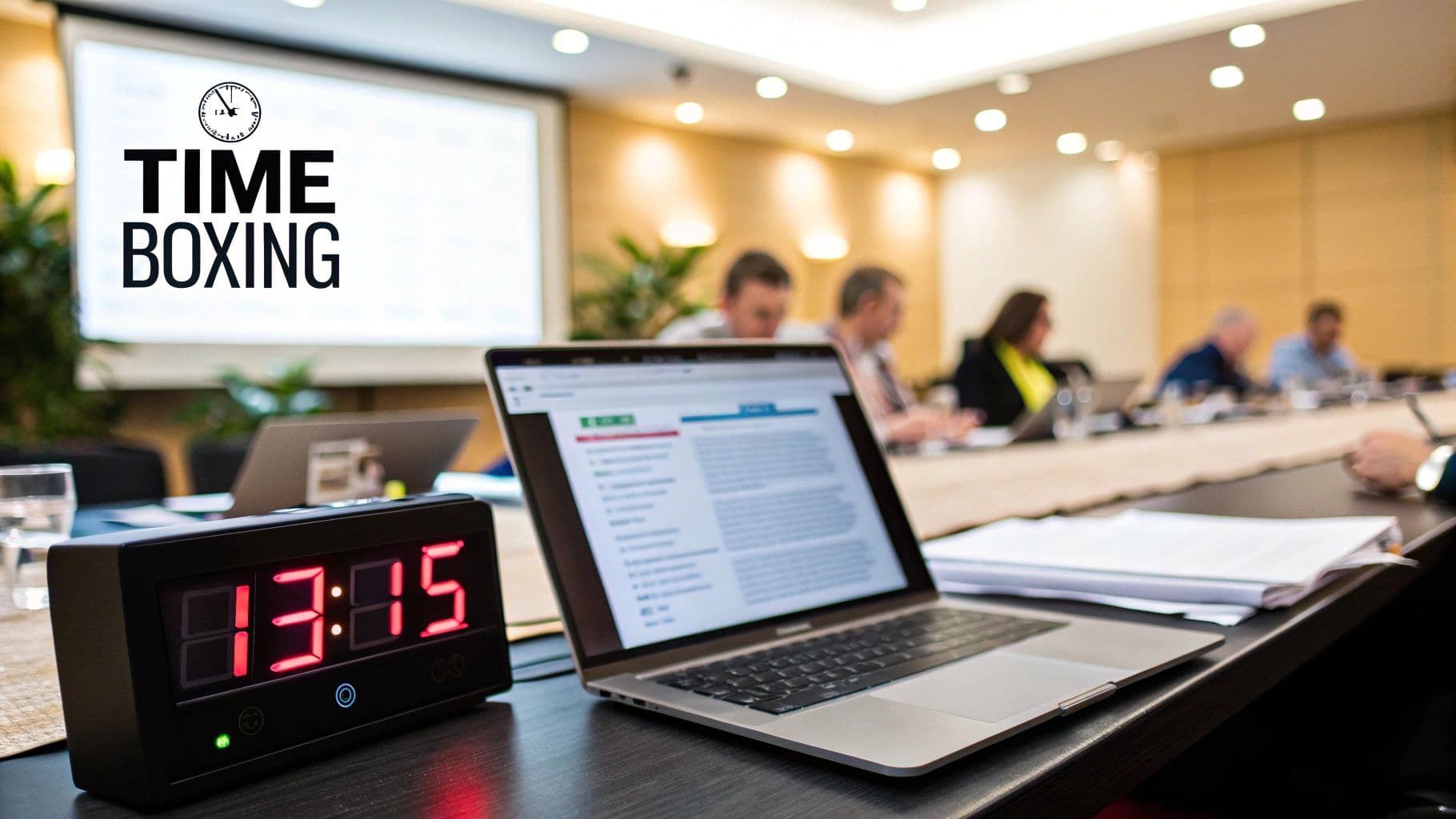
How to Implement Time Boxing in Meetings
Successfully integrating time boxing requires discipline and clear communication. Follow these steps to make your meetings more focused and efficient.
- Assign a Timekeeper: Designate one person (a role that can rotate) to monitor the clock and provide warnings as time limits approach. This keeps the group accountable without placing the burden solely on the meeting leader.
- Use Visible Timers: Display a countdown timer on a shared screen. This visual cue keeps everyone aware of the remaining time for a specific topic, encouraging brevity and focus.
- Adhere to Start and End Times: Make it a non-negotiable rule to begin and conclude meetings exactly as scheduled. This builds a culture of punctuality and respect for everyone’s time.
- Schedule Shorter Meetings: Default to 25 or 50-minute meetings instead of the standard 30 or 60. This provides a natural buffer for attendees to transition to their next commitment without being late.
For example, Atlassian uses time-boxed sprint planning meetings in its agile development process to ensure teams make decisions efficiently and move forward without delay. Similarly, TED Talks famously limit speakers to 18 minutes, a constraint that forces presenters to distill their message into its most impactful form, maximizing audience engagement.
4. Establish Clear Action Items and Follow-up Systems
A meeting without clear outcomes is just a conversation. One of the most critical meeting management best practices is to ensure every discussion translates into concrete action items with designated owners and deadlines. This practice transforms meetings from passive forums into powerful drivers of progress, ensuring that momentum is never lost once everyone leaves the room. By systematically documenting and tracking next steps, you create a culture of accountability and execution.
This approach bridges the gap between discussion and results. It clarifies who is responsible for what, by when, and eliminates the common post-meeting confusion that stalls projects. A robust follow-up system ensures that valuable ideas and important decisions are acted upon, directly contributing to organizational goals.
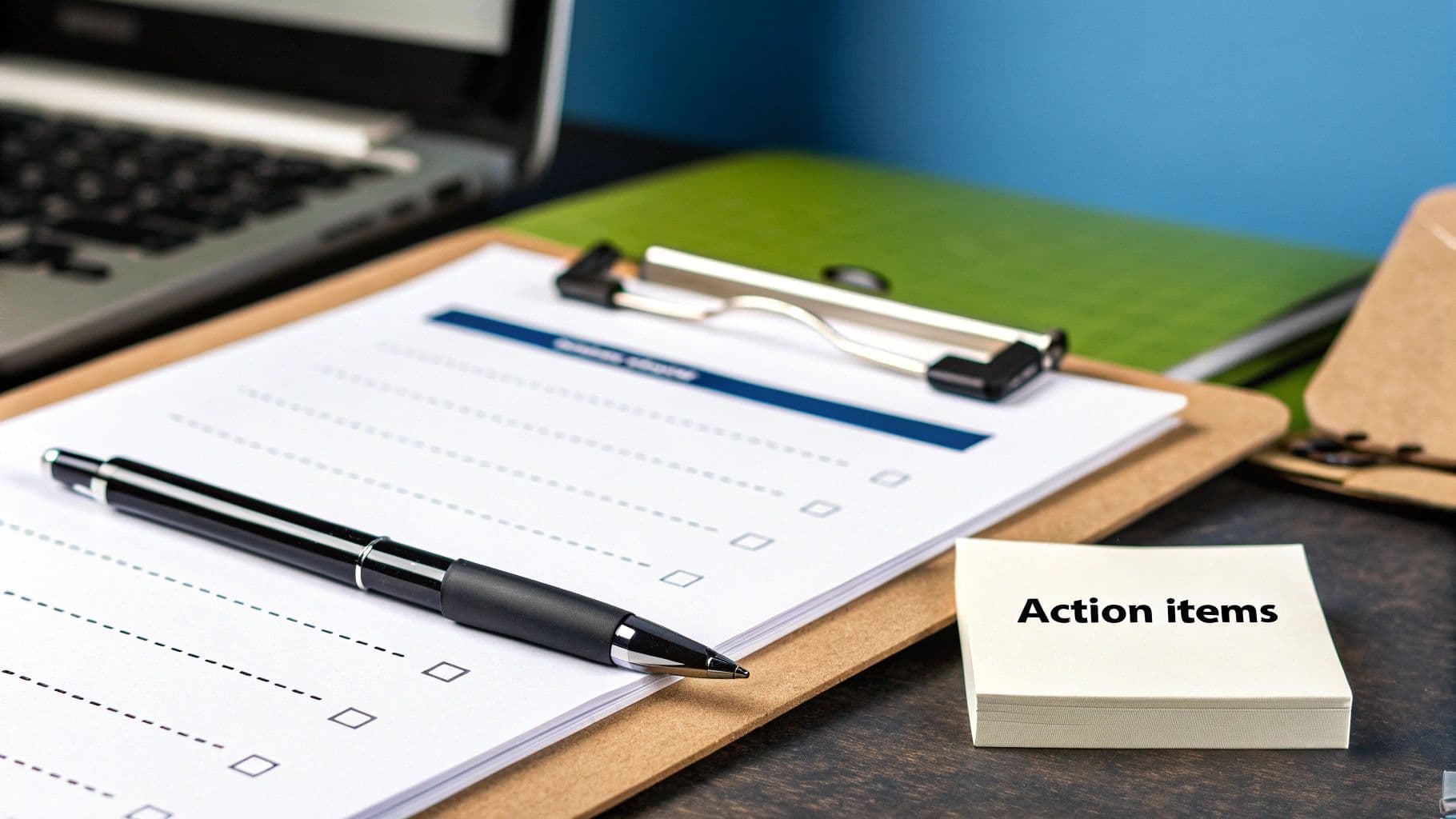
How to Implement Action-Oriented Follow-up
Creating a system for action items requires discipline and the right tools. Follow these steps to build a process that drives accountability and ensures completion.
- Assign and Clarify in Real-Time: Don't wait until the meeting ends. As an action item is identified, assign it to a specific person and confirm they have the capacity and clarity to complete it. State the deliverable and deadline out loud for everyone to hear.
- Use a Centralized Tracking System: Move away from scattered notes. Use shared digital platforms like Asana, Trello, or Monday.com to log, track, and update the status of all action items. This creates a single source of truth for the entire team. To improve your documentation, explore techniques for taking better meeting notes.
- Send a Prompt Summary: Distribute a follow-up email or message within 24 hours of the meeting. This summary should briefly recap key decisions and list the action items, including the owner and due date for each.
- Start the Next Meeting with a Review: Make action item review the first point on the agenda for your next meeting. This reinforces accountability and creates a continuous feedback loop that keeps projects moving forward.
Salesforce operationalizes this with its V2MOM (Vision, Values, Methods, Obstacles, Measures) framework, which aligns meeting outcomes with broader strategic goals. This ensures every action item is not just a task but a deliberate step toward a defined objective.
5. Use Technology Tools Strategically
One of the most impactful meeting management best practices is to leverage technology not just as a necessity, but as a strategic asset. The goal is to select and implement digital tools that streamline workflows, boost engagement, and enhance collaboration rather than adding complexity. This includes everything from video conferencing platforms and shared documents to specialized meeting management software designed to automate documentation and follow-up.
Strategic technology use transforms how teams interact, especially in remote or hybrid environments. When chosen correctly, these tools can break down communication barriers, ensure all voices are heard, and create a persistent, searchable record of decisions and discussions. The key is to align your tech stack with specific meeting objectives and ensure it is accessible and intuitive for all participants.
How to Implement Technology Strategically
Integrating technology effectively requires thoughtful selection and a clear plan. Follow these steps to ensure your tools enhance, rather than hinder, your meetings.
- Align Tools with Meeting Goals: Match the technology to the task. Use a digital whiteboard like Miro for creative brainstorming, a polling tool for quick decision-making, and a shared document for collaborative note-taking.
- Test and Prepare in Advance: Always conduct a brief tech check before the meeting starts, especially with new participants or tools. This minimizes delays and ensures everyone can contribute without technical friction.
- Limit the Number of Tools: Avoid overwhelming participants with too many different platforms in a single meeting. Stick to one or two core tools that serve the primary purpose to maintain focus and reduce cognitive load.
- Provide Clear Instructions: Offer brief guidance on how to use a specific feature, like breakout rooms or live polling. Don't assume everyone is familiar with the technology, as a little instruction goes a long way.
For instance, many design teams use Miro’s digital whiteboard to replicate the in-person brainstorming experience, allowing for real-time, visual collaboration from anywhere. Similarly, the rise of AI-powered tools has revolutionized meeting documentation. To learn more about how technology can streamline your workflow, explore some of the best AI meeting assistant tools.
6. Encourage Active Participation and Engagement
A key element of effective meeting management best practices is fostering an environment where every participant feels empowered and comfortable contributing. A meeting's success depends on leveraging the collective intelligence in the room, which requires more than just inviting the right people. It involves actively facilitating a psychologically safe space where diverse viewpoints are welcomed, quiet members are heard, and dominant voices do not overshadow the conversation.
This inclusive approach transforms a meeting from a passive update into a dynamic collaboration. When participants are engaged, the quality of ideas, decisions, and outcomes improves dramatically. It ensures that critical perspectives are not missed and that the final decision has the buy-in of the entire team, leading to stronger alignment and execution.
How to Foster an Inclusive and Engaging Environment
Creating a culture of active participation requires intentional facilitation techniques. Follow these steps to ensure all voices contribute to the discussion.
- Implement 'No Interruption' Rules: Establish a ground rule that allows individuals to complete their thoughts without being cut off. This simple act shows respect and encourages more thoughtful, comprehensive contributions.
- Use Structured Brainstorming Methods: Employ techniques like the "6-3-5 Brainwriting" method, where six people write down three ideas in five-minute rounds. This silent, written approach gives everyone an equal chance to generate ideas before discussion begins.
- Directly Solicit Input: Instead of asking general questions like "Any thoughts?", intentionally invite quieter participants to share. A simple, "Sarah, we haven't heard from you yet, what are your thoughts on this?" can make a significant difference.
- Leverage Anonymous Polling: For sensitive or contentious topics, use digital polling tools to gather honest opinions without fear of judgment. This is especially effective in virtual settings. You can learn more about how to master engagement in virtual meetings on summarizemeeting.com.
For instance, Google's Project Aristotle identified psychological safety as the single most important factor in high-performing teams. Their meetings prioritize an environment where team members feel safe to take risks and be vulnerable, which directly translates to higher engagement and better innovation.
7. Start and End with Purpose and Energy
Beyond the agenda, one of the most impactful meeting management best practices is mastering the art of the start and finish. The first and last five minutes of any meeting are critical moments that set the tone, drive engagement, and determine whether momentum carries forward. A strong start aligns the team and builds energy, while a purposeful conclusion solidifies outcomes and ensures accountability.
This practice transforms meetings from passive information dumps into dynamic, collaborative sessions. It recognizes that human energy and focus are finite resources. By intentionally managing the beginning and end, you capture attention when it's highest and convert discussion into concrete action, preventing the common problem of great ideas being lost as soon as the meeting ends.
How to Implement Purposeful Beginnings and Endings
Effectively bookending your meetings requires a conscious shift from just "getting started" to strategically "launching" and "landing."
- Begin with a 'Why' Moment: Before diving into agenda items, take 60 seconds to connect everyone to the purpose. This could be sharing a recent customer success story, highlighting a team win, or simply restating the meeting's core objective in an inspiring way. Nike often opens meetings by reinforcing the "why" behind a project to align teams with the company's mission.
- Use an Energizer or Check-In: Start with a brief, structured activity to get everyone engaged. A quick "What's one win from last week?" or a simple personal check-in can break the ice and bring everyone’s full attention into the room.
- End with the 'Three Ws': The most critical part of a strong conclusion is clarity. Summarize the key decisions and then define the next steps using the "Three Ws": Who will do What by When. This simple framework eliminates ambiguity and creates immediate accountability.
- Close with Acknowledgment: Conclude on a positive note by thanking participants for their contributions. Acknowledging specific insights or collaborative efforts reinforces positive behavior and encourages active participation in future meetings.
8. Conduct Regular Meeting Audits and Continuous Improvement
An often-overlooked yet powerful meeting management best practice is to treat your meetings like any other business process that requires ongoing optimization. This involves systematically auditing meeting effectiveness, gathering feedback, and implementing changes for continuous improvement. Rather than accepting inefficient meetings as a fixed cost of doing business, this approach creates a culture where meetings are actively refined to maximize value and minimize waste.
This proactive process ensures that meetings evolve with team and organizational needs, preventing "meeting bloat" and keeping sessions lean, purposeful, and outcome-focused. By regularly questioning the why, who, and how of each meeting, teams can reclaim valuable time, enhance collaboration, and ensure that every minute spent together drives meaningful progress.
How to Implement a Meeting Improvement Cycle
Adopting a continuous improvement mindset for meetings requires a simple yet consistent framework. Follow these steps to audit and enhance your meeting culture.
- Schedule 'Meeting Health Checks': On a monthly or quarterly basis, conduct a brief review of recurring meetings. Use a simple rating system (e.g., 1-5) to let attendees score a meeting’s effectiveness, agenda clarity, and overall value.
- Track the Meeting-to-Outcome Ratio: Measure how many meetings result in a clear decision or completed action item versus those that end without resolution. A low ratio is a clear signal that the meeting's purpose or structure needs reevaluation.
- Create Visible Feedback Loops: When you make a change based on feedback, such as shortening a meeting or changing its format, communicate that change to the team. This shows that their input is valued and encourages further engagement.
- Experiment with Different Formats: Don't be afraid to test new approaches. Try a "walking meeting," a "silent meeting" with a shared document, or a strict "no-slide" rule and measure the impact on engagement and outcomes.
For example, Shopify famously conducted a company-wide meeting audit that led to the cancellation of recurring meetings with three or more people, freeing up an estimated 322,000 hours of employee time. This bold move underscores the significant impact that regular auditing and a commitment to continuous improvement can have on organizational productivity.
8 Best Practices for Meeting Management Comparison
| Practice | Implementation Complexity 🔄 | Resource Requirements 💡 | Expected Outcomes 📊 | Ideal Use Cases | Key Advantages ⭐⚡ |
|---|---|---|---|---|---|
| Start with a Clear Agenda and Purpose | Moderate - requires prep and updates | Time for agenda creation; participant prep | Focused discussions; improved decision quality | Structured, outcome-driven meetings | Increases productivity ⭐; Reduces time ⚡ |
| Follow the Right People, Right Size | Low to Moderate - involves participant selection | Attention to roles and invitations | Faster decisions; higher engagement | Decision-making; small group meetings | Speeds decisions ⭐; Enhances engagement ⚡ |
| Implement Time Boxing and Management | Moderate - time monitoring and facilitation | Timer tools; facilitator skill | On-time meetings; concise communication | Time-sensitive, structured meetings | Respects time ⚡; Maintains focus ⭐ |
| Establish Clear Action Items and Follow-up Systems | Moderate - requires documentation & tracking | Digital tools and admin effort | Clear accountability; tangible results | Project meetings; results-focused sessions | Ensures delivery ⭐; Maintains momentum ⚡ |
| Use Technology Tools Strategically | Moderate to High - tool selection & training | Various software; training time | Remote collaboration; automatic documentation | Remote/hybrid meetings; large groups | Enables collaboration ⭐; Streamlines process ⚡ |
| Encourage Active Participation | Moderate - facilitation and engagement techniques | Facilitation skill; possible tech supports | Inclusive discussions; diverse input | Creative, brainstorming, team-building | Leverages collective intelligence ⭐ |
| Start and End with Purpose and Energy | Low to Moderate - facilitation skill needed | Minimal extra time | Higher energy; clear outcomes | All meetings, especially culture-focused | Sets tone ⭐; Maintains engagement ⚡ |
| Conduct Regular Meeting Audits and Continuous Improvement | High - ongoing evaluation and process changes | Time for feedback, analysis, and implementation | Improved meeting efficiency; adaptive practices | Organizations aiming for continuous growth | Identifies inefficiencies ⭐; Drives improvement ⚡ |
Making Every Meeting Matter
We've explored a comprehensive suite of meeting management best practices, from crafting a purpose-driven agenda to conducting regular audits for continuous improvement. The journey from chaotic, energy-draining meetings to productive, focused collaborations is not an overnight transformation. It's a deliberate, step-by-step process built on consistency and a commitment to valuing everyone's time.
The core message is simple: effective meetings don't happen by accident. They are the direct result of intentional design. When you insist on a clear purpose, invite only the necessary participants, and manage the clock with discipline, you are building a culture of respect and efficiency. Each practice we discussed, whether it's assigning clear action items or fostering an environment of active participation, contributes to this larger goal.
From Good Habits to a Great Culture
Mastering these skills transforms more than just your calendar; it reshapes your entire organizational culture. Well-run meetings lead to:
- Faster, More Confident Decisions: Clarity and focus eliminate ambiguity, empowering teams to move forward decisively.
- Increased Team Engagement: When participants feel their contributions are valued and their time is respected, they become more invested in the outcomes.
- Enhanced Accountability: A robust system for tracking action items and follow-ups ensures that great ideas translate into tangible results.
Think of these best practices not as a rigid set of rules, but as a flexible framework. Your team might excel at timeboxing but need to improve on creating clear follow-up systems. The key is to start somewhere. Choose one or two principles from this guide to implement this week. Perhaps you'll commit to sending out an agenda with specific questions 24 hours before every meeting, or maybe you'll start ending each session with a five-minute recap of decisions and next steps.
Your Action Plan for Better Meetings
The path to transforming your meeting culture begins with small, consistent actions. Here’s how you can start today:
